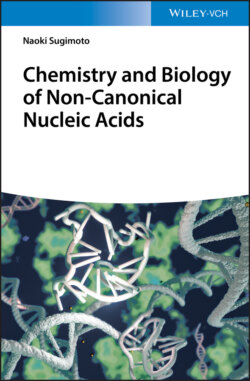Читать книгу Chemistry and Biology of Non-canonical Nucleic Acids - Naoki Sugimoto - Страница 29
2.6.1 Basic Structure Distinctions of RNA
ОглавлениеAs described in Chapter 1, by comparing natural RNA to DNA, there are two difference in their chemical structures. One is the ribose sugar, which bears a 2′-hydroxyl group, and the other is uracil nucleobase, which lacks the 5-methyl group of thymidine in DNA. Regarding structure formation, 2′-hydroxyl group of ribose is the most important factor that confers unique conformational features compared to the DNA. The basic feature that RNA forms an A-type duplex is based on the fact that RNA ribose adopts C3′-endo-type conformation in its sugar pucker due to the presence of 2′-hydroxyl group. The constitutive characteristic that RNA is basically single-stranded is also an important element for RNA to form various secondary and tertiary structures.
Figure 2.7 Typical structures of multi-stranded DNA helices. (a) Canonical duplex (PDB ID: 1BNA). (b) Triplex (PDB ID: 1D3X). (c) G-quadruplex (PDB ID: 139D). (d) i-motif (PDB ID: 1YBL). (e) DNA hexaplex (PDB ID: 2FZA). (f) DNA octaplex (PDB ID: 1V3P). Top views of nucleobase interactions that are located on coplanar region and important for the formation of multi-stranded helix are shown along with the structure. BrC indicates cytosine modified by bromine.
